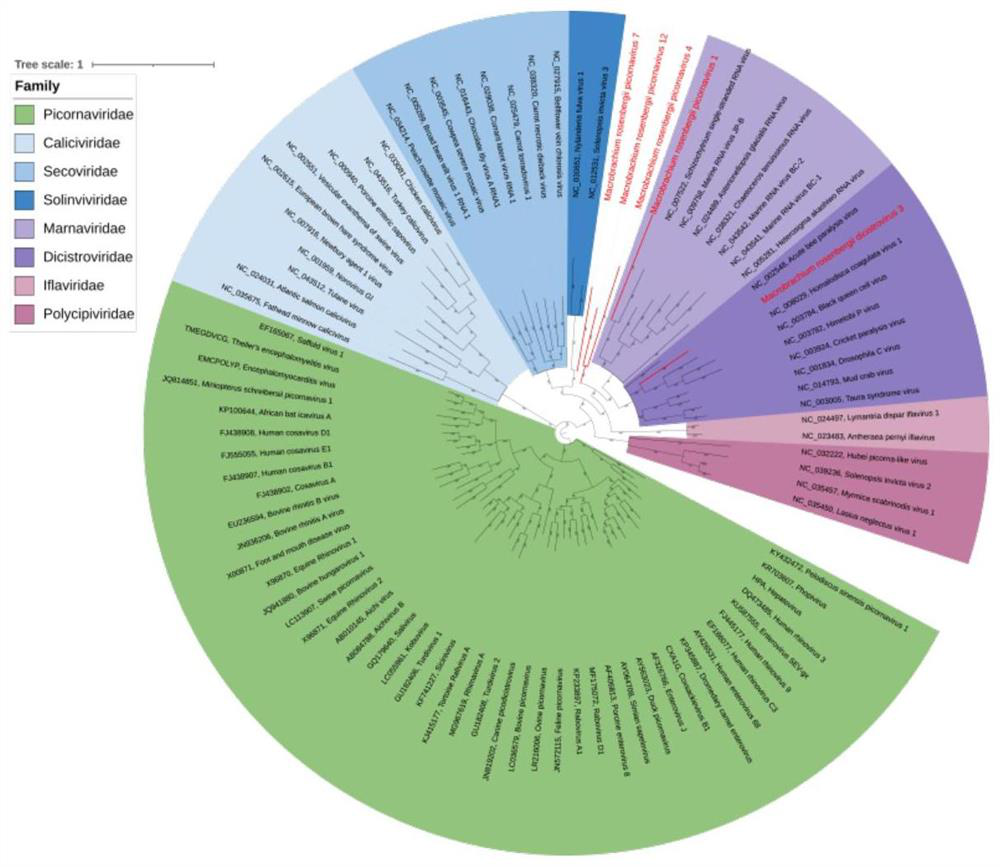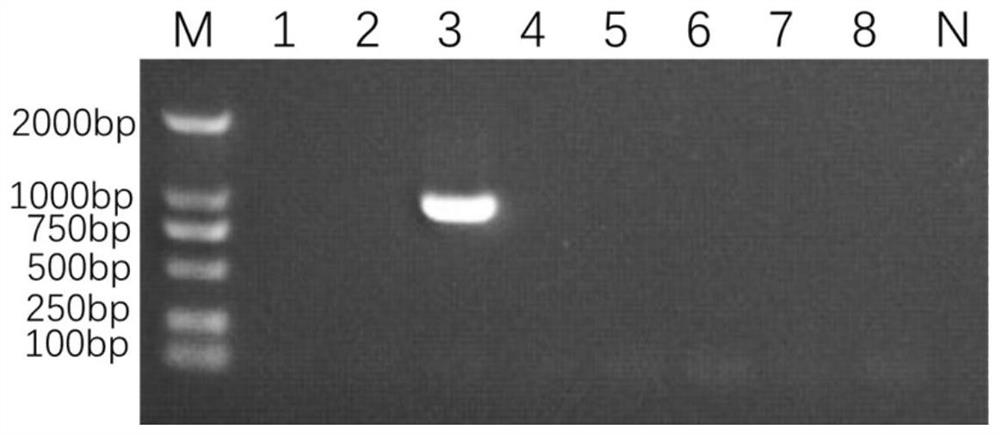Method for detecting small RNA (Ribonucleic Acid) viruses of freshwater long-arm prawns
A technology for freshwater long-arm prawns and RNA viruses, which is applied in the detection field of aquatic viruses, can solve problems such as short time consumption, and achieve the effects of strong specificity, good linear relationship and high sensitivity
- Summary
- Abstract
- Description
- Claims
- Application Information
AI Technical Summary
Problems solved by technology
Method used
Image
Examples
Embodiment 1
[0065] The design of embodiment 1 nested PCR primer and the establishment of PCR method
[0066] 1. Design of nested PCR primers
[0067] The present invention discovers a new small RNA virus tentatively named Macrobrachium rosenbergii picornavirus 7 (MrPV-7) by enriching the viruses in freshwater long-armed prawns exhibiting "iron shell" symptoms and sequencing the macrovirome. ), whose genome sequence is shown in SEQ ID NO.1.
[0068] The present invention refers to the phylogenetic analysis of the Picornaviridae family Picornaviridae by the International Committee on Taxonomy of Viruses (ICTV), and through Bayesian tree building, the representative species of multiple genera in 8 families under Picornavirales are not classified into The tentative species of the genus, as well as multiple MrPV viruses (MrPV-1, MrPV-7, MrPV-4 and MrPV-12) discovered by the inventors of the present invention were analyzed phylogenetically. Because the RNA polymerase of Picornaviridae is resp...
Embodiment 2
[0089] Example 2 Optimization of nested PCR reaction conditions and detection of sensitivity and specificity
[0090] 1. Optimization of annealing temperature
[0091] For the convenience of comparing the impact of different annealing temperatures on nested PCR amplification, the present invention uses a lower concentration of (10 4 copies / uL) of the positive recombinant plasmid as a template, the first round of nested PCR amplification primer MrPV-7-1-F / R and the second round of amplification primer MrPV-7-2- F / R (hereinafter referred to as the first expansion and the second expansion) is amplified, and the annealing temperature corresponding to the brightest band is selected as the optimal annealing temperature. The reaction system is the same as in Example 1, and the experiment is repeated 3 times.
[0092] The results of the first round of nested PCR primers MrPV-7-1-F / R are as follows Figure 4 As shown, the annealing temperatures corresponding to lanes 1 to 6 are 50°C,...
Embodiment 3
[0106] The nested PCR detection of embodiment 3 actual samples
[0107] The present invention utilizes the Nest's PCR detection method constructed to detect the gill samples of 23 freshwater long-armed prawns collected from Huzhou City, Zhejiang Province, and the detection results of the first expansion and the second expansion primers are respectively as follows: Figure 10 and Figure 11 As shown, no bands appeared in the first round of nested PCR amplification, and 17 samples were positive results in the second round of amplification, with a positive detection rate of 73.9%.
PUM
| Property | Measurement | Unit |
|---|---|---|
| Dilution degree | aaaaa | aaaaa |
| correlation coefficient | aaaaa | aaaaa |
| coefficient of variation | aaaaa | aaaaa |
Abstract
Description
Claims
Application Information
 Login to View More
Login to View More - R&D
- Intellectual Property
- Life Sciences
- Materials
- Tech Scout
- Unparalleled Data Quality
- Higher Quality Content
- 60% Fewer Hallucinations
Browse by: Latest US Patents, China's latest patents, Technical Efficacy Thesaurus, Application Domain, Technology Topic, Popular Technical Reports.
© 2025 PatSnap. All rights reserved.Legal|Privacy policy|Modern Slavery Act Transparency Statement|Sitemap|About US| Contact US: help@patsnap.com



